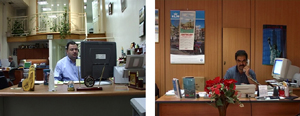5.22.24 — To Their Own Devices
To wrap up on the theme of new media from the last two posts, this past summer I offered a partial report on “Signals” then at MOMA. I did not have time to ask more pointedly what it said about new media—and what that left unsaid. Now that we have time, consider now what it was not. It was not interactive, although you may spot yourself on a monitor now and then.
It was not a record of performance as for Nam June Paik and Richard Serra, an immersive experience as for Bill Viola, a blunt political message as for Martha Rosler, sound art and historical memory as for Susan Philipsz, self-examination as for Lynn Hershman Leeson, or a philosophical meditation as for Gary Hill.  It was not a step toward augmented reality, virtual reality, and AI. You may have seen several of these on the way out, in works from the permanent collection, displayed on nine monitors set in six formidable black boxes. But what do all those nots leave for a decent history or a show?
It was not a step toward augmented reality, virtual reality, and AI. You may have seen several of these on the way out, in works from the permanent collection, displayed on nine monitors set in six formidable black boxes. But what do all those nots leave for a decent history or a show?
MoMA sees video art as political—not just a tool for protest, as for Rosler, but political in itself. The show’s very title points to both. And that means a constant tension between its use on behalf of power and its ability to push back. With Good Morning, Mr. Orwell, Paik himself plays on both. Still not convinced? Me neither, but that is where artist voices take over. They put 1984, the year many people started on the Web, behind them.
This being a trendy affair, here politics is identity politics. It can come from collectives, like the Black Audio Film Collective, with John Akomfrah, and American Artist, a black collective that also appears in “Refigured.” It can be an individual assertion as well, like that of Carlos Motta on gender identity or Emily Jacir between Ramallah and New York. Tony Cokes calls for a “black celebration,” but it will have to settle for plain text on a black screen. More often, though, identity is caught up in a mass movement of people between worlds. And that is where revolution enters the picture.
Nil Yalta speaks for Turkish refugees in Paris, Chto Delat for Crimeans in danger from Russia. Harun Farocki and Andre Ujica have their Videograms of Revolution, Artur Zmijewski his twenty channels’ worth of uprising, as Democracies. This being trendy, too, much here is pro forma, a revolution in spirit but not in the medium or in art. It picks up on the very weakness of the Internet, TV, and their voices. Syms also recites her one hundred and eighty Lessons on blackness, but who needs another lesson? Cacophony really can drown things out.
Yet the medium itself pushes back, starting with so many monitors in the show’s first room. Here images become installations. Yalta’s stack is another Tower of Babel. Ming Wong’s Windows on the World could be a control room, for a television studio or a space station. Motta leans in the opposite direction. His installation all but outgrows its roots in video, with pink triangles for his gayness and striped carpet on the floor.
Some artists leave installations to their own devices, in more ways than one. Dara Birnbaum views revolution and repression in Tiananmen Square through an entire wall of devices, from phones to TVs. Amar Kanwar sets nineteen channels and the torn pages from books and magazines, into wide-open metal frames. Frances Stark uses custom frames creatively, too, for his “mix tapes” of U.S. Greatest Hits (meaning wars), while Information America for Julia Scher spreads out above an ordinary desktop. Stan VanDerBeek invites one into a Movie-Drome. More than anyone else, even Paik, he also takes one back to the real question, the roots of new media.
Those black boxes out front are merely a postscript, but also the most impressive installation of all. Each is a “viewing station,” with a narrow black shelf coming out from the box for seating. Their mass and repetition look back not just to new media, but also to Minimalism—in the same galleries that, three years ago, held Donald Judd. Do they also offer a more honest history of video art? A more traditional history has the last word after all. It has also been televised, and next time it will be on the Web.
Read more, now in a feature-length article on this site.